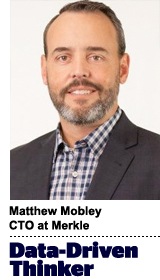 “Data-Driven Thinking” is written by members of the media community and contains fresh ideas on the digital revolution in media.
“Data-Driven Thinking” is written by members of the media community and contains fresh ideas on the digital revolution in media.
Today’s column is written by Matthew Mobley, chief technology officer at Merkle.
At a marketing event I recently attended, there was one aspect that resonated with me the most: the marketing funnel and how marketers should perceive this 100-year-old concept.
Microsoft’s Matt Donovan used the analogy of a swarm of starlings to describe and reshape our perspective of the marketing funnel. His analogy redefines the marketing funnel as a dynamic, nonlinear collection of potential consumer experiences that is unbound by channel or media and maintains a state of ordered chaos. Some of these descriptors are not new in the way marketers talk about the marketing funnel, but the beauty of the analogy is that it captures the essence of what today’s marketer must attempt to understand and align with to be effective.
Starling flocks are flexible within constantly changing environmental factors, with all birds flying in a unified formation with a common goal. As a marketing technologist, I began to question why marketers haven’t been able to successfully master this swarm concept in the marketing funnel and what existing limitations may be present in marketing technology. What I determined was that there may not actually be any major hurdles from a technology standpoint.
Yes, some challenges do exist with regard to constraints, such as time, money and the lack of expertise, all of which can create technological barriers. Some organizations have failed to optimize their marketing technology capabilities. They either use legacy technology or have allowed isolated groups to define the use of specific components without holistic thinking across the marketing funnel. The latter is twice as troublesome as the first because it subdivides the technology through a lack of vision and understanding of how marketing has evolved and where it continues to move.
So while the technology is capable, the limitations to the marketing funnel achieving a “swarm” are due to the lack of a dynamic and flexible system centered on unified and integrated data. Very few companies are organizationally ready to support the optimal use of marketing data for this funnel, but many believe they have the technology. The issue is the technology is not integrated, and therefore the data layer is not integrated.
Technology value is only defined by the data it uses. But organizational silos specifying how specific technology components are used is a key cause leading to suboptimization. It can be driven by either a self-serving business need – perhaps I need to meet my metrics and am not focused on the overarching marketing goals – or a lack of vision (I can’t even see the starlings swarming).
There are numerous examples. The email team, for instance, may select an audience for an email blast, but fails to share this audience with the media team for search, display or social campaigns. Meanwhile, the media team creates an audience in its data management platform (DMP), but fails to think of how the audience could be used for personalization. The team that manages the next-best-offer engine leverages machine learning to optimize messaging, but fails to update the media team’s DMP, which would impact how they are buying media.
Each of these teams acquired a set of technologies to effectively do the same thing: select an audience to target in their marketing channel. Simple technology integrations could easily tie these pieces together and allow the organization to react to the appearance of a member of that audience in any channel or media. Organizations, however, haven’t conquered this obvious issue, partly due to their myopic nature. Only a small number of companies are relatively confident that their organization can meet this challenge.
It is time for a transformation. Organizations must divorce the acquisition of technology from solely supporting a single channel or media. They need to develop a long-term, holistic technology strategy for marketing and adopt a strategic technology planning processes. The time for self-serving, accidental marketing architectures must come to end.
Today’s marketers must have a set of capabilities that can dynamically interact with the consumer through an optimized and highly relevant message regardless of the channel or media. Interestingly enough, marketers already have many of these technologies but have been short-sighted in realizing their full potential.
Follow Merkle (@merkleCRM) and AdExchanger (@adexchanger) on Twitter.
This post was syndicated from Ad Exchanger.

More Stories
How This Kid-Focused Media Company Balances Privacy And Ad Measurement
McDonald’s, DDB tout ‘spiciest’ burger
TechMagic Podcast: The Promise and Caveats of AirChat